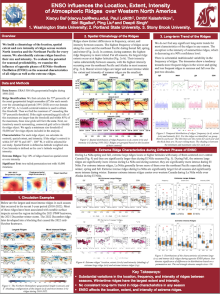Seasonal characteristics of atmospheric ridges in the Pacific North and North America and during ENSO
Xiaoyu
Bai
Washington State University
Poster
Atmospheric ridges are key drivers of mid-latitude weather including extremes such as heatwaves, droughts, wildfires, and extreme precipitation across western North America. Although the physical drivers of atmospheric ridges and their response to projected warming have been investigated, a comprehensive climatology of the spatial and temporal characteristics of ridges and the influence of natural variability on these characteristics has not yet been developed. Using ERA5 reanalysis data from 1950 to 2022, we develop a seasonal climatology of the frequency, extent and intensity of the atmospheric ridges across the northeastern Pacific and western North America. Using this dataset, we identify extreme ridges as the top 5% of their historical extent and intensity in each season and examine the influence of warm and cold phases of El Niño-Southern Oscillation (ENSO) on their characteristics. First, we find that the largest ridges tend to cluster at higher latitudes and the most intense ridges tend to cluster at lower latitudes. Second, ENSO events influence the location, extent and intensity of both types of extreme ridges in multiple seasons. La Niña conditions increase the likelihood of intense ridges during the boreal winter and fall, with more occurrences over the northeastern Pacific Ocean. La Niña conditions also increase the likelihood of large ridges during the boreal spring, summer and fall. In contrast, El Niño favors more large ridges during the boreal winter especially over the northeast part of our research area. Third, ridges in the boreal winter ridges are becoming larger, more intense and more frequent over the past three decades while ridges in the boreal summer have a decreasing trend in their extent and frequency. The relationships we identify between ridge characteristic and ENSO can inform seasonal predictability of these atmospheric features and their associated surface climate impacts.

Poster file
Bai_Xiaoyu_blocking_poster.pdf
(7.49 MB)
Meeting homepage
